Tell us about the software preservation program at your organization.
We don’t yet support software preservation programmatically. We primarily undertake software preservation as a means of supporting appraisal activities and accessing legacy scholarship. However, we have begun laying the groundwork for better coordinated and systematic software preservation through the development of a local file format registry, a knowledge-base where we record information about accessing legacy and otherwise challenging file types not typically addressed in depth in other file format profiling tools. In the file format registry we document what software can be used to render a file, related dependencies, and we have the capability to document access pathways such as migration or emulation strategies used to render a file.
Additionally, through our involvement in the Fostering a Community of Practice (FCoP) and Software Preservation Network, we hope to gain more tools for advocating and supporting coordinated software preservation and access efforts.

What has your organization accomplished recently that you’re proud of – big or small?
In 2018 we were selected to participate in the Fostering a Community of Practice (FCoP) project. Together, with five other organizations, we are embarking on software preservation and emulation projects to establish a community of practice within libraries, archives, and museums.
We are proud to have been selected to participate in such a leading-edge project that will help other institutions refine their approaches to emulation and software preservation.
Tell us about a challenge that your organization is facing in its software preservation work or that the field is facing as a whole?
I think that many institutions struggle with a lack of staff and available bandwidth to dedicate to some of the more time-intensive software preservation and curation activities, including: identifying software title versions and related dependencies; documenting those dependencies in relation to local content curation needs; securing those required titles and versions (if they’re even available); developing the knowledge to understand how the software operates and its requirements; as well as maintaining technical infrastructure in a scalable manner.
Digital preservation professionals at many academic institutions are often tasked with myriad, challenging responsibilities but have limited resources. Digital preservation professionals within a single institution may be solely responsible for or aware of software preservation issues, or efforts may occur in silos.
Name a software title or library that is particularly significant for one or more of your user constituencies, and tell us why that title or library is particularly significant.
At UIUC, we have collections representing world-renowned composers and audio production professionals from Illinois. Many of these professionals used ProTools, a proprietary and widely-used production software, to create their work. ProTools “sessions” and “projects” are complex collections of dependent and related files wrapped up into one big proprietary file that depends on the ProTools software environment to open and explore. We are interested in preserving ProTools because it would be impossible to see the creators’ process without this software to render the session and project files.
Why is collective action the best approach to software preservation?
Often, there isn’t enough time or resources available to a single institution to effectively engage in all aspects of the software preservation process.
Working together, we as a community can elevate and collectively examine the challenges surrounding software preservation, including legal concerns, access to the source or binary code libraries, and knowledge development and sharing.